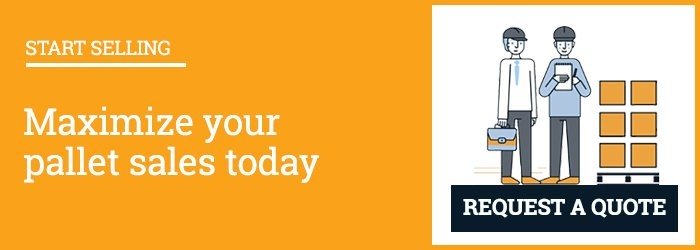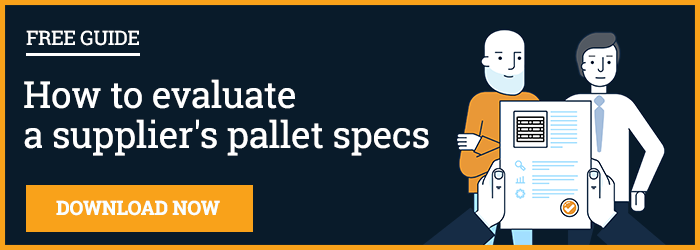How to Get Your Money’s Worth on Selling Used Pallets
The value of recycled pallets is on the rise—make sure you're maximizing your income from pallet retrieval transactions.
Have you heard the saying “One man’s trash is another man’s treasure?”
That’s exactly what’s going on in the recycled pallet industry. With lumber prices up, the value of recycled pallets is also on the rise and retailers can make a lot of treasure selling their used pallets to pallet recyclers rather than trashing them.
Seems like a simple transaction, right? But like everything else that should be simple, getting one’s money out of used pallets—known in the industry as cores—can be anything but. Let me explain what I see in the field.
The big issue is load count accuracy or lack thereof. Foodservice distributors, grocers, manufacturers, retailers and other pallet generators rely on pallet recyclers to provide accurate load counts. However, load counts often vary, sometimes wildly so, from the point of retrieval to arrival at recycling yards, and finally are sorted into one of three categories: cores for reuse, scrap and pooled pallets. Companies are provided with spreadsheets of totals with very little or no support data from the recycling facility. Suffice it to say that final quantities and invoice often don’t align with the seller’s expectations.
[Not sure how to evaluate pallet specs? Learn more about making sure a supplier's specs will meet your needs here.]
Further complicating the accuracy issue is the entry of pallet brokers into this market. Brokers add more contact points to the supply chain that may not have accurate load counts. Yet they are responsible for compensating sellers. Multiple steps mean opportunities for errors and this lack of data and transparency can make it challenging for sellers to get top dollar for their used pallets.
See the frustration?
48forty has a three-part solution that helps ensure companies maximize income through greatly enhanced accuracy and transparency from pallet retrieval transactions.
Step 1: Create a traceable, transparent digital footprint for every pallet load collected.
When a customer contacts 48forty to retrieve used pallets, we create a digital sort sheet within PalTrax®, our online customer portal. This establishes a traceable digital footprint for each load of retrieved pallets. 48forty drivers carry tablets that provide electronic bills of lading (B/L) as loads are signed off on at the retailers dock. The B/L is connected to the digital sort sheet to document the load count within PalTrax. The pallet count is verified as the trailers are offloaded at a 48forty facility before going to sort tables. All pallets are accounted for.
[The right supplier is based on your needs and how well the supplier's capabilities align. Get the full guide on how to select the right supplier here.]
Step 2: Update the digital documentation once cores are sorted for an accurate final count.
As mentioned earlier, used pallets are sorted into three categories of different value: cores for reuse, scrap and pooled pallets. Once a load is sorted, the final count is added to the retailer’s digital sort sheet on PalTrax. This count determines the final purchase price for the seller. The customer can login to PalTrax and see the original B/L, the sorted count and final invoice to 48forty.
Step 3: Provide total visibility of individual loads as well as entire order history to retail customers.
The PalTrax portal provides a complete view of customer activity with traceability to B/L through invoicing. Retailers and core generator customers have 24/7 access to pallet grade sheets to substantiate trailer load counts and blends of cores, scrap, and pooled pallets. The record also includes invoices based on pallets collected and their grades by location. Users can look at individual loads or entire order history and can drill down into original bills of lading.
Get the latest industry insights and actionable advice every week.
The reason this three-part, IT-enabled solution works and works well for national as well as local pallet sellers is that it’s backed by 48forty’s team of national sales managers and our 39 company-owned and operated pallet-recycling facilities across the United States. Each 48forty location is locally managed and serves as a personal point of contact for customers and has a dedicated team of drivers, tractors, and trailers available for immediate dispatch 24/7.
[Vetting potential pallet suppliers? Conduct site visits before you make the final decision. Here's what to look for.]
Currently, 48forty is the only pallet solutions provider that has a digital, online mechanism for retailers and other pallet generators to accurately track, over time, the number of cores retrieved, sorted and invoiced, by load and by location. Additionally, 48forty is the first company to provide this data on demand to its customers via our online customer portal, PalTrax.
We think this is the right way to do business because it helps ensure our customers get their money’s worth out of each and every core.
I’d like to hear what you think. If you’d like to speak with me or another member of 48forty’s national sales team on how to maximize your used core sales, contact us here or give us a call at 877.779.8577.


